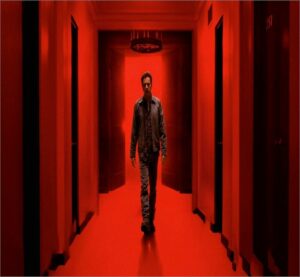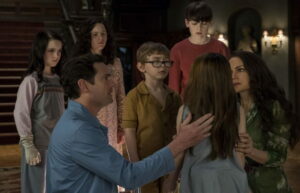A Ghost Can Be a Lot of Things: Mike Flanagan’s Take on Horror and Trauma
লেখক: Rupsha Barman
শিল্পী: Team Kalpabiswa
“Most times, a Ghost is a Wish”
Steven Crain remarks in The Haunting of Hill House (2018)
The popular American filmmaker known for creating horror flicks, Mike Flanagan doesn’t just use horror for scares—he uses it as a plot device to confront horrifying traumatic events one would rather bury. In Flanagan’s world, the real horror lies not in what we see, but in the pain, we try to escape.
Horror is often associated with darkness and jump scares, ghosts and demons, strategic silence, and screams. Though there is a good chunk of movies that portray horror like that, Mike Flanagan’s work proves how versatile a plot device horror can be—serving not just to terrify, but to tell profound, emotionally charged stories.
Using horror as a narrative tool allows the realistic horrors of trauma to be discussed in a way that provides emotional distance for the audience because of the inclusion of supernaturalistic, fantastical elements. This approach allows viewers to engage with difficult subjects without being overwhelmed by their intensity—much like watching an animated car crash. The layers of fiction soften the blow, making the confrontation of painful truths more bearable. By using supernatural or otherworldly forces, horror provides a buffer to examine and process heavy themes like grief, loss, and fear through the lens of ghosts or monsters, from a safe distance, allowing for reflection and empathy rather than experiencing the immediate emotional weight and confronting the raw emotional reality directly. This blend of terror and metaphor transforms horror into a powerful vehicle for discussing deeply human experiences in a way that feels engaging, rather than paralyzing.
Role of Trauma in Flanagan’s work:
Flanagan’s approach to horror and storytelling revolves around the portrayal of ugly truths of the past, and how unresolved trauma resurfaces to haunt his characters in the present. In most of his stories, these supernatural beings are not mere entities, but manifestations of the characters’ buried trauma.

In the horror fantasy film, Before I Wake (2108), eight-year-old Cody is haunted by a creature he describes as ‘The Cranker Man’ in his nightmares, with glowing yellow eyes and shriveled skin stretched over a skeletal frame. As the story unfolds, it is revealed that the creature’s name stems from Cody’s mispronunciation of the word “Cancer”, and the Canker Man is Cody’s fading memories of his mother; pale and disfigured due to the cancer.

Another example of how trauma shapes and controls Flanagan’s characters is Danny Torrence, in Doctor Sleep (2019), the sequel to The Shining (1980), adapted for the screen by Mike Flanagan, based on Stephen King’s book. Danny tormented by his childhood trauma from his alcoholic abusive father, which culminated at The Overlook Hotel, ends up replicating the actions of the monster he wanted to escape. He walks on the same crooked path of alcoholism as his father he ends up taking two lives becoming a bigger monster than his father who attempted to kill his wife and child. However, Danny never has to face any real repercussions for it, and he only learns about it through his psychic abilities, referred to as ‘The Shining’ – the spirits of those whose deaths he had caused, haunt him day and night. This proves to be a turning point when he decides to take back control of his life. Through Danny’s journey, Flanagan illustrates how the cycle of trauma can distort one’s identity and how breaking free from it requires both confronting the past and accepting responsibility for one’s actions.

In The Haunting of Hill House (2018) all or most of Flanagan’s characters are shaped by personal traumas, like grief, addiction, guilt, and loss of a loved one, and they are intricately woven into the tapestry of this story. The five siblings lost their mother tragically, at a time when they were too young to know death. Hugh, a father first and husband after, did what he thought was best to protect his children from the truth. A loss like that shaped them all differently. Steven, the eldest of the siblings, unbeknownst to what happened that night, thought that their mother was mentally ill, she needed psychological help and blamed their father for negligence and never giving them the closure they deserved. Shirley, before experiencing her mother ‘s death, had had a few brushes with death. It made her so scared of death and the dead, that she was reluctant to even see her mother for the last time at the open casket viewing. She grows up and opens a funeral service of her own, where she would embalm the dead herself, and make them look so that the family of the deceased would be able to remember their loved one as they had always seen. Theo, the most empathetic character, was said to be sensitive and possess the power of “seeing” things. She saw the happenings of that night in a vision, it made her cold and distant. Arguably the most well-adjusted of them all, Theo used her powers to help troubled kids, and yet, she couldn’t very well help her troubled self. Nell and Luke, the twins, the youngest of the bunch, had it the worst. They experienced the loss before they could even begin to understand it. Nell stayed unhappy for most of her life, and Luke became a drug addict.
The psychological alteration caused by such traumas adds an emotional depth, which is central to the story. The Haunting of Hill House has ghosts, but the stories of the characters are far more horrifying and emotional, in fact, so much so, that seeing supernatural beings adds a rather welcoming distraction for the viewers and an element of fantasy, making all of it distress the viewer a little less than it would’ve, had it been an all-real story.
Horror as a Narrative Buffer for Trauma:

Midnight Mass (2021) stands as a compelling example of how Flanagan uses horror as a narrative buffer to explore deeply rooted trauma.
The show employs one of the most classic and far-fetched tropes of the horror genre—the vampire—however in the context of manifestation of trauma caused by religious dogmatism, the vampire as the prime supernatural being in the show, makes perfect sense, following Flanagan’s logic.
Set on an isolated, remote island, Midnight Mass portrays a small, tightly-knit community that is deeply entrenched in religion, with its entire social structure centered around the church and its enigmatic priest. The island is portrayed as a relic of a bygone era, cut off from the modern world, with a simple way of life characterised by modest homes, hunting rifles, and unwavering faith. The characters here are not just dealing with personal loss or grief but are grappling with a collective trauma—a kind of spiritual stagnation and emotional isolation that mirrors the island’s geographic isolation.
The vampire, in this context, becomes more than a mere supernatural antagonist. It symbolizes the destructive power of blind faith and religious extremism, and how trauma can be perpetuated through dogmatic beliefs. Flanagan uses the vampire as a metaphor for the dangerous allure of salvation promised by religion, especially in a community that has been suffering for so long. The priest, himself blinded by his faith, introduces the vampire as an “angel” that could save them all, and give them the gift of eternal life. The greed of Bev Keene, blinded by religion, manifested in her personality as self-righteousness and moral superiority. She weaponizes religion to justify her manipulation and control over others, believing her actions are divinely sanctioned while disregarding the harm she inflicts on the community.
The same cause that killed all of them also proved to be the redemption of Riley, who was dealing with the grief and guilt of taking an innocent life because of his alcoholism. In an attempt to save the island and its people from himself, he sacrificed his own life, but not without providing Erin the closure she deserved.
Through this lens, Midnight Mass becomes a study of how horror allows space to engage with difficult themes like religious trauma without being overwhelmed by them, giving viewers enough emotional distance to process the unsettling realities of fanaticism and spiritual manipulation.
Balancing Horror and Emotional Storytelling:
The Haunting of Bly Manor (2020) might be, Flanagan’s most emotionally charged story. While the characters of Hill House were all tied by the same tragedy, Bly Manor is an amalgamation of stories of people who don’t know each other but are tied by fate.

There are several subplots in the show, all constructed towards a gut-wrenching climax. Mikey doesn’t shy away from twisting the knife. The main storyline follows Danielle (Dani) Clayton. She takes up a job at an old English Manor as an au pair to two orphaned kids. Dani is the quintessential Flanagan protagonist; she is haunted by her past. The past she so desperately wanted to escape drove her to seek a job far from home.
Similar to Cody’s nightmares in Before I Wake (2016) Dani has visions of her fiancé, his glasses glowing and him always staring still, unable to move or do anything; she is haunted by a traumatic incident from her past. She’s haunted by guilt, the guilt of surviving, the guilt of betraying her fiancé, the guilt of being different. But when she faces what haunts her, it makes her brave. Brave enough to give life another shot. The gardener at Bly Manor, Jamie, helps her through it. The caretaker of the Manor, Hannah, the caring, lovely, scared woman, was haunted by her denial. The denial of her death, she was so adamant about not leaving, that she couldn’t leave. She was stuck in a dream, her first conversation with Owen, who she loved dearly. She would dream and wake up and find herself to be in the same dream again, and again. A punch to the gut. The kids are haunted by the loss of their loved ones. Their previous au pair and the uncle’s assistant died. One of them died in an accident of rage. The other is because of manipulation. The children, young and impressionable, didn’t know any better. They had their heart in the right places but it would torment them, they would dream and wake and find themselves in places they didn’t remember getting to. If it wasn’t for Dani they would’ve died too. The backstory of Bly Manor, which ties the past, present, and future with the thread of fate, is a haunting tale far from pleasant. It’s a story of love, loss, and the inevitable grip of time, where the consequences of past actions bleed into the present, trapping souls in an endless cycle of sorrow and longing. An unfaithful lover and a betrayal by her sister, Viola died angry and unsatisfied. Her Ghost, driven by pure unforgiving rage and vendetta, seems to even have forgotten what she was mad about. Over the years, the ghost had forgotten the life of Viola—her memories, her death, and everything in between. This gradual loss of identity is symbolized by her fading facial features, which eventually rendered her faceless, a haunting reflection of how time erases even the strongest of wills. What remained of her was a husk driven only by rage and the memory of a child whose very face she had forgotten. Ultimately, Dani becomes the one to quiet her rage. Dani, the survivor, then the savior, lived a life, being haunted by the fear of her present being taken away from her. Until the point that she couldn’t bear with it anymore. Jamie, her partner, and Owen spent the rest of their lives being haunted by the void that their partners had left behind.
The Role of Horror in Processing Trauma
“Art should comfort the disturbed and disturb the comfortable.” ―Cesar A. Cruz.
Mike Flanagan’s take on horror is refreshing and cathartic. It has a certain hope, a rawness, a humanity. The depiction of serious issues through his characters, who survive the test of time, the cruel past, the hopeless present, and the uncertain future is a testament to hope even in horror. It goes to show how irrespective of our struggles, it is possible to be brave in the face of an adversary and come out of the other side like a winner. A great example would be Luke Crain, from The Haunting of Hill House. Luke, tormented by a tragedy in his childhood and ghosts of his past, turns to drugs for salvation. Familial intervention and a hefty amount deposited at the rehab counter, get him registered at the facility, but getting sober is far more difficult than doing drugs. He falls back to old patterns but stands up on his feet again. Eventually, he makes it past 90 days of sobriety, but that’s when he comes face to face with the loss of half of his soul, his twin. Though dealing with grief and the laced past was complicated, and it must have been easier to blame it on the situation to start using again, Luke survived. He made it through to the other end and came out a winner. An interesting detail of the show is that the “Tall Man” ghost, Luke is haunted by as a child and is found to be the ghost of William Hill who was a rather short man, insecure of his height. Most times, a Ghost is a Wish. After his death, he felt bigger than ever. Luke in his 90-day sobriety speech at the rehab, said he was always a scared little kid, through the years, he didn’t feel like he had changed at all, small, unsafe, threatened by the world, an allegorical connection to William Hill.
“A true horror film would be unwatchable” ―Michael Haneke.
Among the many ways horror can be portrayed, Flanagan and Haneke stand at the opposite spectrums of the “comforting the disturbed and disturbing the comfortable” axis. The portrayal of similar issues looks very different through their lenses. “Gerald’s Game” by Mike Flanagan and “The Piano Teacher” by Michael Haneke, are both movies that are based on parental abuse. While Flanagan shows the protagonist take charge of the situation and face their adversaries, Haneke shows his protagonist as a victim of their situation, a monster by default. Both are significant filmmakers, and we might not be able to appreciate one without the other, such is the balance of art. However, Flanagan’s approach to trauma has gentleness, warmth, and responsibility for the gravity of the issues in question. Check out the quote from the book:
“To learn what we fear is to learn who we are. Horror defies our boundaries and illuminates our souls.”
―Shirley Jackson, The Haunting of Hill House(1959)
A remarkable work of Flanagan’s, which is relatively new and could be your next watch, is “The Fall of the House of Usher”, it’s different from most of his work and therefore stands out. It takes quite a bit of inspiration from the works of Edgar Allan Poe. His poem “The Raven” has been used quite extensively, not only as a monologue of a main character itself but also to draw inspiration for visuals, dialogues, character names, and a subplot.
Flanagan is truly a genius when it comes to storytelling and doing Horror right!
Tags: English Section, Rupsha Barman, নবম বর্ষ প্রথম সংখ্যা

